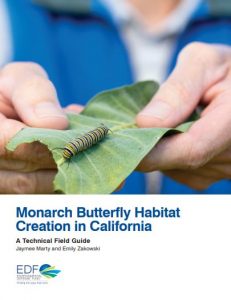Last summer, unlike some of my graduate student peers, I traded in palm trees for almond orchards, with soil instead of sand beneath my toes. I spent the summer counting milkweed stems and sifting through literature from Xerces Society and university scientists, seeking to understand the challenges and opportunities associated with establishing monarch butterfly habitat in California.
As part of my research role with EDF, I’ve been working to address the declining western monarch population by making habitat restoration and creation more accessible and, ultimately, more effective.
The culmination of my research, conducted with ecological consultant Jaymee Marty, is summarized in a new resource now available to working land managers in California, Monarch Butterfly Habitat Creation in California: A Technical Field Guide.
Guide published just in time for spring planting season
This user-friendly technical field guide couldn’t come at a more critical time to support monarch restoration efforts across the state.
With the western monarch population down 86 percent from last year, it’s essential that land managers and conservationists optimize planting efforts in California this spring – the ideal time of year for planting.
To help land managers do this, the guide builds upon conservation work already done on the ground in the Central Valley of California – a key agricultural region that has historically been a vital breeding range and migratory route for the monarch. The guide includes firsthand knowledge and lessons learned from recent restoration efforts in the region, including projects at Triangle T Ranch and Davis Ranches.
If we have any chance of changing the trajectory for this iconic species, we have to focus conservation efforts on the working farms and ranches in the Central Valley, and this guide will offer a clear, no-nonsense means for landowners to be a part of the monarch solution. New guide helps farmers and ranchers maximize existing and future conservation efforts to help save the monarch butterfly Share on X
Making monarch conservation as easy as 1-2-3
Since many growers are already supporting monarchs and other pollinators on their land – growing habitat in hedgerows, buffer strips, crop margins and other out-of-production areas – we didn’t feel the need to reinvent the wheel with this guide. Rather, the guide offers a simple roadmap for growers to maximize existing and future conservation efforts.
It summarizes the best available scientific and practical information on restoring native milkweed and other native plant species important to monarch butterflies as breeding and nectar sources, in three main sections:
- Planning: Information on where to plant habitat at a particular site and what species of plants to include.
- Establishing habitat: Guidance on seeding/planting rates, planting methods and more.
- Site management: Details on timing, irrigation, pest control and other specific information on site maintenance.
This general guidance can be supplemented with more detailed, location-specific information available from local seed suppliers, naturalists, native plant societies and extensive resources available online. Some of these additional resources are embedded in the guide.
Benefits beyond monarchs, for the farm and for all
The resources offered in this guide for planting native milkweed and wildflowers on farms will not only provide food and shelter for the monarch butterfly, but also support beneficial insects for agriculture such as pollinators and natural predators of pests.
Nectar-rich resources help support native bees and honeybees, making them more reliable for crop pollination. Other beneficial insects have been shown to be attracted to milkweed species, which can provide support for attacking crop pests through natural biological control and integrated pest management. Additional benefits to agricultural landscapes include enhanced weed control, air and water quality protection, and soil erosion control.
There’s never been a better time or reason for California growers to be excited about the potential to enhance the resilience of their farms – both for the monarch butterfly and for the broader agricultural ecosystem.











3 Comments
The guide provides no photos or links to videos showing large patches or fields of western milkweeds that were successfully established from scratch on a western farm nor photos and videos showing alot of full grown caterpillars and some chrysalids could be found on the plants.
So it’s not clear to the reader that establishing large patches or fields of milkweed is easy nor clear that monarch reproductive success is good on the planted plants.
That’s unfortunate there are lots of great websites for planting Milkweed and growing monarchs from caterpillar to butterfly. The key is always Native Milkweed for the region… as well as other beneficial wildflowers. The caterpillars have a success rate of generally 1 out of 100 making it to butterfly. They are huge consumers of the Milkweed. The Milkweed is the only plant monarchs lay their eggs on and is crucial.
https://industries.basf.com/assets/north-america/us/en/Agriculture/Crop%20Protection/Sustainability/2016-monarch-brochure.pdf
I’m glad you put a short guide together, but there are a few things I wanted to touch on.
First, I’ve never heard that seed balls are a method of targeted planting, rather the opposite. I’ve also heard that they have low success rates. Milkweed in general does not do well when seeded. I hope folks don’t make a lot of seedballs and waste precious milkweed seed as a result of this guide. I’m also surprised you didn’t mention efforts to plant them by rhizome, which the Lockeford Plant Materials Center is trailing in partnership with Xerces.
Also- I agree that pastures can be rested after a milkweed planting project, but in general in California rangeland is grazed year-round and not rotated. Yet milkweed and cattle co-exist well. We should ensure ranchers get the message that they are key to milkweed management and won’t have to drastically alter their management practices- instead they can shift to view themselves as milkweed stewards and stop trying to actively reduce milkweed populations on their properties.